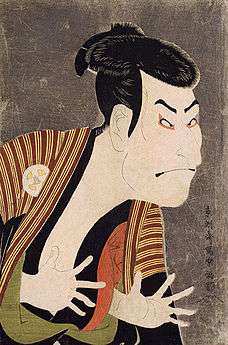Hikime kagibana
Hikime kagibana describes a feature of illustration continuing in the repertoire of Japanese Art from the Heian period through the Kamakura period, most notably in yamato-e e-maki. Its influence can be traced right up the Edo period ukiyoe or later.

Scene from The Tale of Genji by Tosa Mitsuoki, from the 17th century Tosa school revival of the yamato-e.
Works done in the hikime kagibana style show faces with essentially identical features.:[1] slit eyes and hook nose. The Hikime Kagibana style also does not allow a full front view of a face. There are only two main viewpoints used to depict faces: an oblique angle of 30 degrees from the front and a right angle giving a profile. When faces are shown from a right angle, the eyebrows and corners of the eyes are visible but the nose is not -- something that is not possible in actuality.
References
- ↑ Okudaira, Hideo (1973). Narrative picture scrolls. Arts of Japan 5. Weatherhill.
This article is issued from Wikipedia - version of the 7/17/2016. The text is available under the Creative Commons Attribution/Share Alike but additional terms may apply for the media files.
